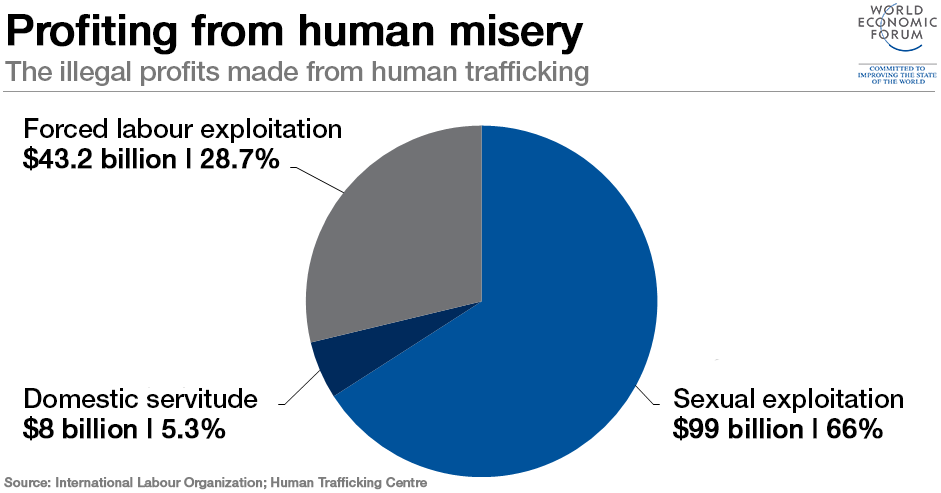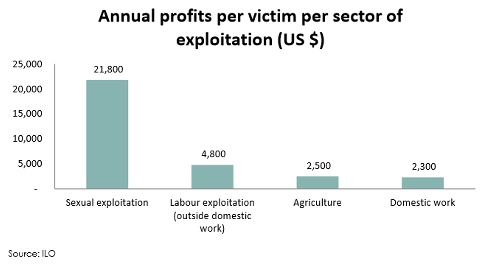This insightful and informative article comes to us from Ajay Dave, member of the University of Texas at Dallas Free Project chapter.
Economists apply math and statistics to human behavior to identify trends and patterns in supply and demand. These two forces drive economic theory and influence our individual decisions. Globalization has created an international market driven by a network of buyers and sellers that sprawls across the globe. There are many determinants of supply and demand, many of which we don’t understand or that we deem insignificant. However, if the butterfly effect, a mathematical theory describing the far-removed effects of seemingly insignificant actions, is true in any discipline, it would be economics.
Human trafficking occupies a dark corner of the formal market, but it’s regulated by the same laws of supply and demand, which means it exerts influence on the formal market. While it may be difficult to see the trafficking market, it’s definitely measureable. According to the International Labour Organization (ILO), the trafficking trade nets over $150 billion annually, tailing behind only drugs and arms smuggling in terms of criminal revenue streams.1

Image from World Economic Forum
Considering that traffickers don’t pay their enslaved workers, traffickers retain approximately 70% of their profits after costs of slave transportation and logistics are subtracted, according to Dasra, a philanthropic think-tank based in India.2 Those profits aren’t invested in the goods and services of the formal market. Traffickers don’t need to look farther than their own sordid businesses to reinvest their profits and grow their lucrative operations. Massive sums of money remain locked away from the formal market and can’t be harnessed for economic growth.
Not only do traffickers vacuum money away from legitimate markets, but they also make it harder for legal workers to get jobs.3 Trafficking occurs at multiple levels in the supply chain, or the flow of raw resources to finished goods. Traffickers specialize in stages of production that they deem most profitable, including manufacturing, harvesting, mining, packaging, and distribution. People who actually want jobs in those industries can be crowded out by the forced labor market because forced laborers aren’t paid wages.

Image from International Labour Organization
Many view human trafficking synonymously with the sex trade. While sexual exploitation accounts for a large amount of trafficking profits, many revenues flow from domestic work, mining, agriculture, and construction.4 Those forced into these industries work from dawn until dusk without pay. They can’t contribute to their local economies by purchasing other goods and services. Nor can they work efficiently. Forced labor doesn’t provide for educational opportunities or healthcare, which means that enslaved individuals lack skills and the healthcare they need to perform optimally even if they wanted to. The Global Slavery Index estimates there are at least 45 million slaves in the world.5 That’s 45 million people who could have contributed to the global economy with greater efficacy if they had the resources needed to perform at their full potentials.
To remedy these economic symptoms of human trafficking, we must address the socioeconomic disparities that often force individuals into slavery. The ILO has espoused a protocol that would create a global network that would regulate international supply chains and insulate them from trafficker influence. Individual nations, even wealthy, developed ones like the United States, should also fight against growing economic disparities, especially in migrant workers. This can be accomplished through education programs targeting at-risk children, worker skill-training and slavery awareness programs, support systems for financially-strained individuals, and government laws regarding immigration and employment.
Sources
- “ILO says forced labour generates annual profits of US$ 150 billion,” ILO.org, last modified May 14, 2014, http://www.ilo.org/global/about-the-ilo/newsroom/news/WCMS_243201/lang–en/index.htm
- Ton, Ahn. “The Cruel Economics of Human Trafficking in India,” Asianphilanthropyforum.org, last modified February 28, 2014, http://www.asianphilanthropyforum.org/cruel-economics-human-trafficking-india/
- “Trafficking in Persons Report 2009,” State.gov, accessed April 19th, 2017, https://www.state.gov/j/tip/rls/tiprpt/2009/124798.htm
- “Labor Trafficking,” Polarisproject.org, accessed April 19th, 2017, https://polarisproject.org/labor-trafficking
- “Global Findings”, Globalslaveryindex.org, accessed April 19th, 2017, http://www.globalslaveryindex.org/findings/
